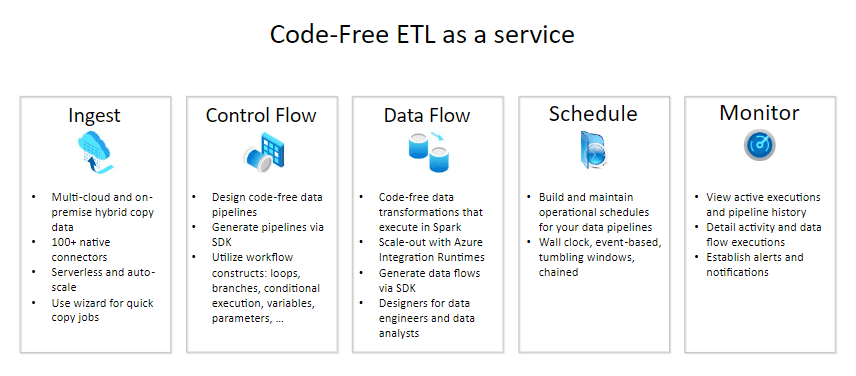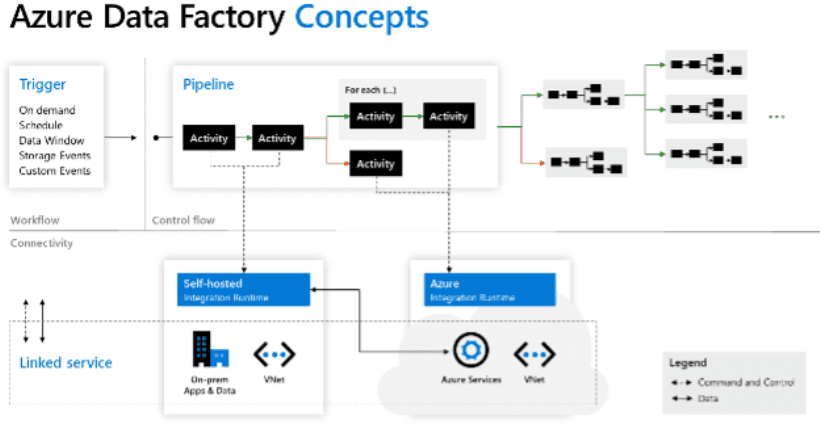Microsoft Fabric and Azure
Written By: Sajagan Thirugnanam and Austin Levine
Last Updated on October 1, 2024
In today's era of exponential data growth, organizations are constantly seeking innovative ways to streamline their data integration and management processes. Azure Data Factory, a robust cloud-based service provided by Microsoft Azure, has emerged as a game-changer in this space. With its powerful capabilities and seamless integration with various data sources and services, Azure Data Factory empowers businesses to orchestrate and automate complex data workflows effortlessly. In this article, we delve into the world of Azure Data Factory, exploring its key features, benefits, and real-world applications

Source: microsoft.com
Key Features of Azure Data Factory:
Azure Data Factory offers a comprehensive set of features designed to simplify and enhance data integration and management processes. Its key features include seamless data ingestion from diverse sources such as on-premises databases, cloud-based applications, and even IoT devices. With built-in connectors for popular data platforms and services, Data Factory enables organizations to easily collect and ingest data at scale.
Data transformation is another critical aspect of Azure Data Factory. It provides a visual interface for creating data pipelines, allowing users to extract, transform, and load (ETL) data with ease. With support for various data transformation activities, including filtering, aggregating, and schema mapping, Data Factory ensures data quality and consistency before delivering it to the desired destinations.
Additionally, Azure Data Factory offers robust data movement capabilities. It enables efficient data movement between different data stores, both within and across cloud environments. Whether you need to migrate data to a new cloud platform, replicate data for backup or disaster recovery purposes, or distribute data for analytical processing, Data Factory provides reliable and scalable data movement operations.

Source : pluralsight.com
Benefits of Azure Data Factory:
By leveraging Azure Data Factory, organizations can experience numerous benefits. Firstly, it enables efficient data integration across hybrid environments, bridging the gap between on-premises systems and cloud-based services. This flexibility allows businesses to harness the power of both worlds, enabling seamless data movement and integration between diverse sources.
Another significant advantage is the scalability and cost-effectiveness offered by Azure Data Factory. As a cloud-based service, it leverages the inherent scalability of Azure, enabling organizations to handle large data volumes and accommodate growing demands without the need for significant infrastructure investments. Moreover, Data Factory follows a pay-as-you-go pricing model, ensuring that businesses only pay for the resources they consume, thereby optimizing costs.
Real-World Applications of Azure Data Factory:
Azure Data Factory finds applications across various industries and use cases. For instance, in the retail sector, Data Factory can be employed to consolidate sales data from multiple point-of-sale systems, providing a unified view for analysis and reporting. In the financial industry, it can facilitate data integration between different banking systems, enabling seamless transaction processing and risk analysis.
Furthermore, Azure Data Factory plays a crucial role in IoT data processing. It can ingest and process streaming data from IoT devices, facilitating real-time analytics and decision-making. Additionally, Data Factory is instrumental in enabling data warehousing and analytics solutions, allowing organizations to integrate data from different sources into a centralized data repository for advanced analytics and reporting.
As the demand for data integration and management continues to grow, Azure Data Factory remains at the forefront, empowering organizations across various industries. Whether it's streamlining retail operations, enabling financial analysis, processing IoT data, or facilitating advanced analytics, Azure Data Factory offers a flexible and scalable solution.
Related to Microsoft Fabric and Azure
